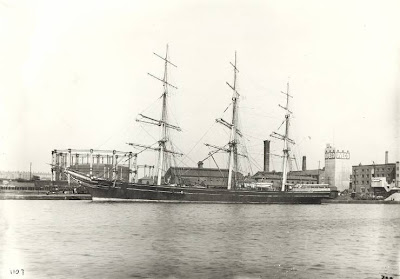If ever you're going to get a new record there, get "Oh Miss Hannah!" great fun, believe me. And think that it has a better moral than H.H.H. Letter to Carol Brown May 1926 in Collected Letters of Malcolm Lowry.
I have already posted a feature on "Oh Miss Hannah!" by the Revelers. Sherrill E. Grace, the editor of Lowry's Collected Letters has suggested that the song Malc refers to as H.H.H. is possibly "Hard Hearted Hannah". More than likely, the version Malc would be familiar with would have been Belle Baker's song from 1924.

Belle Baker (25 December 1893, New York City, New York - 29 April 1957, Los Angeles, California) was an American singer and actress.
Born Bella Becker, she rose to fame as a vaudeville vocalist, appearing on Broadway and in nightclubs, films, radio and television.
In the early 1920s, when she was well known as The Ragtime Singer, Baker took part in a Baltimore song competition with Catherine Calvert, the Hamilton Sisters (Pearl and Violet) and Jessie Fordyce. She was the first artist to record "All of Me," one of the most recorded songs of its era, and she was also the first person in the United States to do a radio broadcast from a moving train.
In 1926, Baker had the title role in Broadway's Betsy. She introduced Irving Berlin's "Blues Skies" in the Florenz Ziegfeld production, which ran for 39 performances from December 28, 1926 to January 29, 1927. With music by Richard Rodgers and lyrics by Lorenz Hart, the musical comedy had a book by Irving Caesar and David Freedman. Victor Baravelle was the musical director.
On radio, she was a guest performer on The Eveready Hour, broadcasting's first major variety show, which featured Broadway's top headliners. After roles in the films Song of Love (1929) and Charing Cross Road (1935), she appeared as herself in Atlantic City (1944).
She was married to the composer Maurice Abrahams (1883-1931), who wrote the songs "I'm Walking with the Moonbeams (Talking to the Stars)" and "Take Everything But You" for Song of Love. The couple had one child, Herbert Baker. On September 21, 1937, she married Elias E. Sugarman, editor of the theatrical trade magazine, Billboard.
She died of a heart attack in 1957 at Cedars of Lebanon Hospital in Los Angeles. Wikipedia
It is also possible that Malc was referring to the very popular Savoy Orpheans who had a regular radio show where Malc may have heard the song?
Hard Hearted Hannah Fox Trot (Yellen, Bigelow & Bates) Savoy Orpheans at the Savoy Hotel, London HMV B1955/Bb5643-3 Hayes, Middlesex 21.1.1925.
Here's a great version of the song by Ella Fitzgerald from 1955:


















.jpg)






old1.jpg)






